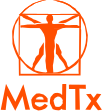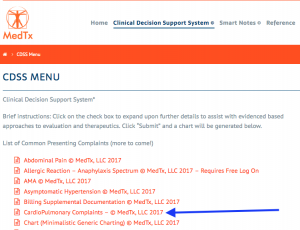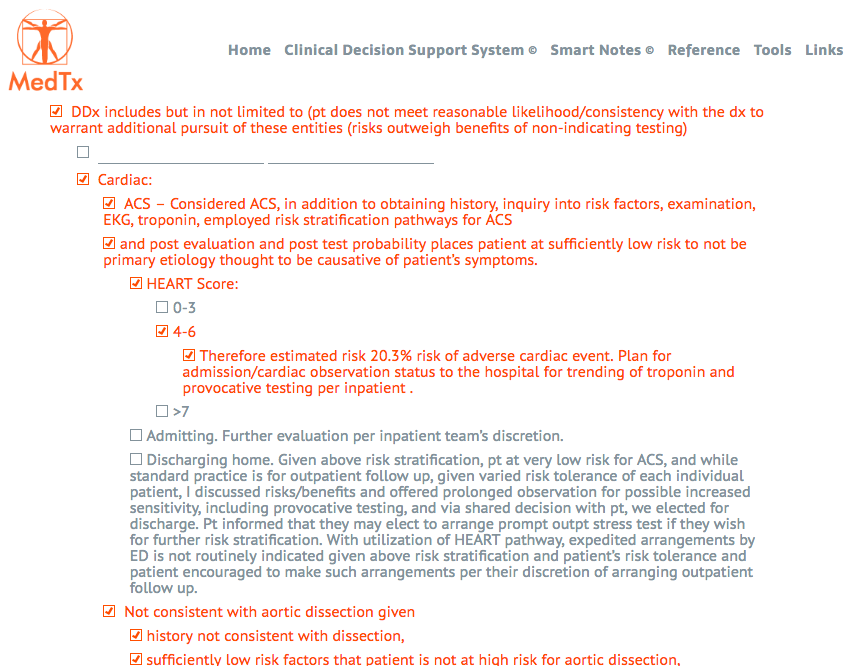ABOUT: MedTx’s flagship product is a cloud-based Clinical Decision Support System that utilizes an interactive, dynamic repository of clinical decision support decision trees in order to:
(1) reduce preventable errors by provision of POC evidenced-based guidelines and suggested guidelines for diagnostics and treatment of the most common presenting complaints to the ED,
(2) significantly reduce time documents to maximize time for physicians to see more patient, be at the patient bedside, or teach by employing an automated dynamic system that creates a customized chart for patient,
(3) mitigate medical-legal liability by providing peer-reviewed standards of care recommendations with additional attention to high-risk topics, and
(4) minimize under-billing secondary to missed documentation of by automating the ever changing billing requirements to chart accurately without having to remember billing/charting/coding technicalities.
MedTx has applications for providing your group’s own standardized approaches to mid-level providers or to physicians (while still allowing for the clinician to deviate as he/she feels is indicated). Your group can create or request creation of individualized algorithms and they can be immediately implemented. The algorithms can be created by making a structured bullet point outline by any member of the group and do not require any coding nor IT experience. Our program converts the text to an interactive cloud-based application.
MedTx can be used by clinicians or scribes. It can be used on an iPad/tablet and syncs to the desktop workstations. It is hosted on a HIPAA compliant domain with 64-bit encryption. Provision patents are pending. Two-way integration can be implemented with any of the major EMRs. It is being beta-tested in multiple EDs. It is designed by a clinician for clinicians with an intuitive, streamlined user interface (UI).
THE TEAM:
- Founder, CEO: Trevor C. Wilson, MD
- In-House Counsel: Marina S. Pantchenko
- Senior Content Reviewers and Developers: Multiple, Further Information Provided Upon Request.
ABOUT ME: I am a resident in Emergency Medicine at Harbor-UCLA Medical Center.
- Main Menu. You can pick to use any of the features including the Clinical Decision Support System.
- Please pick the decision tree that most appropriately corresponds to the patient’s chief complaint (e.g. pick Cardio-Pulmonary Complaints for a patient that presents with Chest Pain).
- Fill out the chart. Please note when you check a box, it places the text on that line into the medical chart that will be created. Checking a box also opens up the sub-trees of that topic and thereby prompts the user with the next diagnostic or therapeutic step.
- By checking on the Differential Diagnosis box, it will open a set of diagnoses that should be considered based upon the patient’s information. You may elect to check (include) some of the diagnoses in your differential or not depending on your clinical impression.
Medical Chart:
- After clicking on “Generate Chart,” a full chart is generated below including the HPI, ROS, PMSFH, EXAM with VITALS, A/P, and DISPOSITION. Scroll up or down to reveal more of the chart. It may be copied into the EMR of your institution. Upon request, we can set up two-way integration with any major EMR with our corporate partner, ReDox.
BEFORE MEDTX: THE EXISTING PROBLEM The structure of our healthcare system has imposed increasing demands on the emergency physician. Emergency medicine physicians spend more time charting than doing patient care. (Hill, Sears, and Melanson 2013) More and more clinical decision rules are being implemented for commonly seen chief complaints in the emergency room and have been shown superior to clinical gestalt. (Long and Koyfman 2016) However each of these clinical decision rules requires that the patient meets a specific set of criteria and failure of even one of these criteria would nullify the application of the clinical decision rule to the patient’s specific scenario. Physicians find themselves, inundated with the details of clinical decision rules, and therefore constantly utilize electronic resources to cross reference the patient’s specific scenario with the details of the clinical decision rule. This requires an interaction with the patient, incorporation of the patient’s information into the working memory of the physician, opening an online reference with the clinical decision rule, ensuring that all of the criteria of the critical decision rule have been met, and then following the subsequent directions for appropriate pathway. After all the aforementioned steps have been met, the clinician must document the details of the patient’s history thereby showing that the patient meets the criteria specified in clinical decision rule, the applicability of the clinical decision rule, how it was utilized, and the conclusion from the clinical decision rule, and therefore the clinical plan to be implemented.
ENTER: MedTx, a cloud-based, HIPAA secure, medical application that accomplishes all of the aforementioned steps in one singular system with concurrent creation of documentation and ability to integrate with EMRs. Additional attention is focused on high risk for preventable errors and medico-legal exposure in Emergency Medicine.
EDUCATIONAL VALUE: The Smart Notes repository of MedTx provides structured approaches for commonly encountered complaints and medical issues encountered in the Emergency Department. The structure is designed to allow a trainee to follow the same structured approach to the patient’s clinical evaluation and Medical Decision Making while utilizing Clinical Decision Rules (CDSS), guidelines, and evidence based management concurrent to providing structured documentation on said encounter. The goal is to concurrently teach a trainee a multi-part process (i.e. learn how to evaluate the patient, learn how to employ appropriate medical decision making, and then document it each of the aforementioned processes) into one streamlined process.
UNINTENDED CONSEQUENCES: Patients don’t read the textbooks and they sure don’t read MedTx’s Smart Notes. As such, anyone using this technology needs to be cognisant of this potential bias to put a patient into the pre-completed box and should be vigilant of signs suggestive that a patient may not fit that pathway. Such cases are, of course, require deviation from any preconceived pathway with development of a new plan based upon the unique characteristics of the patient’s scenario.
DISCLAIMER: The views of this company and site do not represent the views or opinions of the Harbor-UCLA Medical Center. MedTx, LLC has no official affiliation with the Harbor-UCLA Medical Center. Given the content is still is the peer-review process, MedTx is not liable for error and the care of the patient is the sole responsibility of the provider of record.





